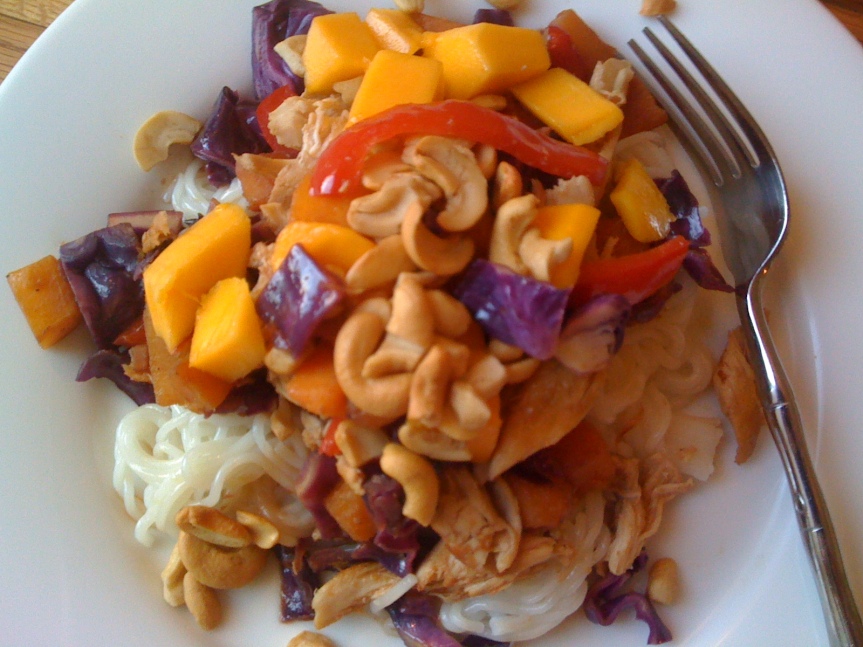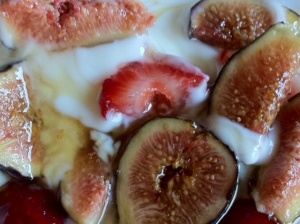Perhaps an unexpected combination of vegetables, this salad dances the line between sweet, savory, and sour. Hitting all notes perfectly. The chopped red cabbage provides crunch and a slight bitterness which pairs perfectly with the sweet butternut squash, and bright, juicy mango. In addition, the red pepper creates the slightest bit of spice and further sweetness. It’s all capped off with oodles of crunchy cashews. Of course feel free to make this vegetarian by skipping the chicken, or add any protein you wish.
The unexpected star of this dish is really the red cabbage. Sadly, this is one of the most over-looked vegetables, and is really only eaten in the form of coleslaw often swimming in pools of mayonnaise. But, its nutritional benefits are great and shouldn’t be dismissed. Part of the cruciferous family of vegetables, (think broccoli, cauliflower) it’s thought to help cleanse and protect the body. Similar to blueberries, red cabbage contains polyphenols which provide antioxidant, anti-inflammatory and anti-cancer benefits to the body.
This stir-fry is truly better than anything you could buy pre-packaged and is exponentially better for you, feeding your body with nutrients it wants and needs. I have to say, this combination is a bit addictive, especially with the addition of the light sweet and sour dressing. Serve this atop rice noodles.
Crunch, nibble, and happily slurp away!
Sweet and Sour Red Cabbage and Butternut Squash Stir-fry with Shredded Chicken, Mango, and Cashews
Adapted from The New York Times
Yields: 4 servings
- 2 tablespoons low-sodium tamari
- 1 tablespoons rice wine vinegar
- 2 teaspoons honey
- 2 teaspoons dark sesame oil
- 2 teaspoons cornstarch
- Heavy pinch ground ginger
- 2 tablespoons extra virgin olive oil
- 2 boneless/skinless chicken breasts
- 2 garlic cloves, minced
- 3/4 pound butternut squash, cut in 1/2-inch dice
- 1 cup red bell pepper, julienned
- Salt to taste
- 1 1/2 pounds red cabbage, cored and coarsely chopped
- Flesh of one large mango, diced
- 1/2 cup toasted cashews
- Rice noodles for serving
In a small bowl, whisk together 1 tablespoon of the tamari, the rice wine vinegar, honey, sesame oil and cornstarch. Set aside.
Heat 1 tablespoon of the oil over medium-high heat. Add the chicken and sauté until cooked through and golden brown. Remove from the pan, and season to taste with 1 tablespoon of tamari. When cool enough to handle, shred the chicken.
Add the remaining oil to the pan. When it is hot, add the butternut squash. Stir-fry until it begins to color, five to eight minutes. Add the bell pepper and sauté for two minutes or until it begins to soften. Add salt to taste, and the ginger and garlic. Stir-fry for about 30 seconds, and add the cabbage. Stir-fry until the squash is tender and the cabbage is crisp-tender, about six minutes, adding about 1/4 cup water to the pan from time to time if the vegetables begin to stick. Return the chicken pieces to the pan.
Stir the sweet and sour dressing, and add to the vegetables. Stir just for a few seconds until they are glazed. Remove from the heat and serve atop rice noodles. Top the stir-fry with mango and cashews.














